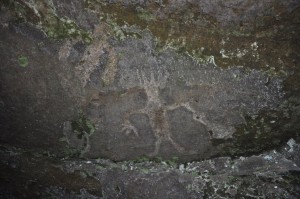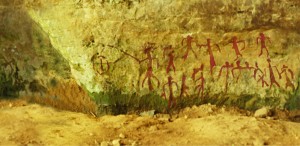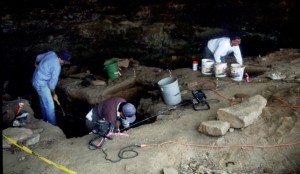Rock Art at the Narrows

The Narrows is a bluff shelter in the Boston Mountains that has been known to both locals and archeologists in the region for many years. It is known primarily for its spectacular rock art which depicts several human figures, or what archeologists call anthropomorphs. Among the rock art at The Narrows are 28 anthropomorphic figures represented on 5 separate areas or panels—the most people represented in one place in any rock art site in Arkansas. Do these figures represent a story, a ceremony, a dance? All of these are possibilities.
One of the figures (shown to the right) is wearing what is interpreted as a feather headdress. It is represented by the vertical lines emerging from the head. The object the anthropomorph is holding in his or her left hand is interpreted as a mace or club—symbols of chiefly power in the late prehistoric period. The differences in dress, adornment, and objects among the figures may denote social categories. The adornment or object might have told the contemporary viewer what kind of person the figure represented—a leader, a religious person, a warrior, or a craftsman. Thus, the representation of symbols of power, as seen in this figure, means a complex social organization existed in the society that created these images.
One of the more elaborate panels at The Narrows depicts what Dr. George Sabo, who has extensively investigated Arkansas rock art, has interpreted as a dance scene. Sabo believes that the choreography depicted in this panel appears to be remarkably similar to historic Osage dances celebrating a traditional narrative accounting for the origins of their community via descent of the souls of their ancestors from the “Above World” to explore and then inhabit the surface of the earth.

Pictographs and Petroglyphs
The rock art in this shelter is mostly painted petroglyphs. This is a combination of the two different kinds of rock art—pictographs and petroglyphs. Pictographs are made by using pigment of some sort and applying it to the rock using fingers or brushes. Petroglyphs are made by abrading, pecking, or incising the rock with another object like a rock. Painted petroglyphs like those at The Narrows are carved or pecked into the rock and then painted over using pigment.
Two colors of pigment appear in rock art at The Narrows, red and black. The red pigment was probably made from hematite—the mineral form of iron oxide. The black pigment was probably made from manganese. Both hematite and manganese were found in the excavations at the shelter and showed wear consistent with processing for use as pigment. Stones covered in red pigment were also recovered during excavations at The Narrows.
Archeology & Dating Rock Art

Rock art is difficult to date—with a few exceptions. For example, we can say that rock art that depicts horses has to date after the reintroduction of horses by European traders and settlers. Directly dating the binder or pigment in rock art is a difficult, expensive, and experimental process. It is much easier to date other artifacts known to be the same age as the rock art. This rarely happens. This is why The Narrows site is so special and interesting.
In 1995, Jerry Hilliard led archeologists from the Arkansas Archeological Survey and volunteers from the Arkansas Archeological Society to conduct limited excavations at The Narrows. Despite decades of looting, Hilliard was able to identify areas of undisturbed deposits in the shelter. These deposits revealed that in the mid-fifteenth century the shelter had been used to process fall and winter nuts (such as hickory nuts), and manufacture siltstone tools, among them hoes. Prehistoric Native Americans were not using the hoes at the shelter (in the rugged Boston Mountains), but rather taking them for use in gardening and farming along the Mulberry or Arkansas Rivers.
Hilliard’s excavations also revealed pigments and tools related to the creation of rock art at The Narrows. Thus, the radiocarbon dates on hickory nut shell, along with particular ceramic types, point to the fact that at least some of the rock art at The Narrows dates to the mid-1400s and may be related to the Late Mississippian ceremonial site of Spiro Mounds in the Arkansas River Valley.